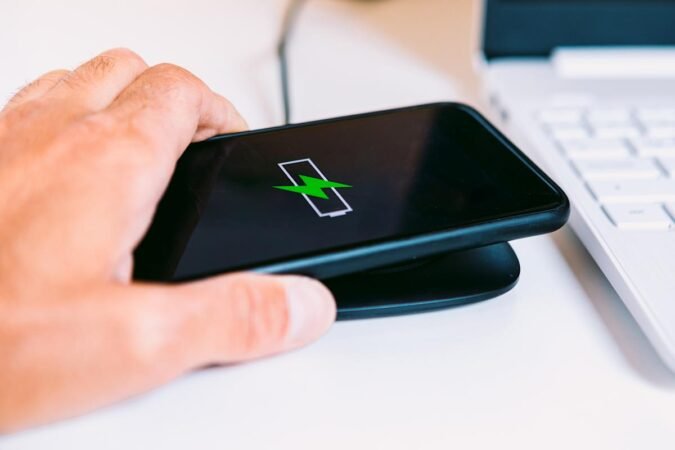Top Highlights
-
Convenience vs. Speed: Wireless charging enhances convenience by eliminating cables, but achieving optimal speed requires the right equipment and setup, as many users experience slower-than-expected charging.
-
New Qi2 Standard: The introduction of the Qi2 standard allows for automatic magnetic alignment, improving efficiency and permitting faster charging speeds (15-25 watts) compared to the previous generation.
-
Max Power Limitations: Each smartphone has a maximum power limit for wireless charging, influenced by hardware and software settings; using less powerful chargers than the phone’s capability can significantly slow charging speeds.
-
Setup for Efficiency: Proper alignment, suitable cases, high-quality chargers, and effective heat management are crucial for maximizing wireless charging efficiency and minimizing overheating during the charging process.
How to Wirelessly Charge Your Phone with Max Power
Wireless charging offers a convenient way to power up smartphones. You simply place your device on a pad and watch the battery percentage rise. However, many users experience slower charging speeds than anticipated. Here’s how to maximize your wireless charging power.
Understanding Wireless Charging
Wireless charging operates through electromagnetic induction. When you set your phone on a compatible pad, a coil in the charger generates an electromagnetic field. This field transfers energy to a coil in your phone, converting it back into electricity. Efficiency hinges on the alignment of these coils and the charging power they can deliver.
The Qi standard has dominated wireless charging for years. Nearly all major smartphones support Qi, making it easy to mix and match devices and chargers. Recently, the Qi2 standard rolled out, featuring magnetic alignment that improves power transfer and efficiency. Qi2 can deliver 15 to 25 watts, speeding up charging times significantly.
Max Power Defined
Each smartphone has a limit on how much power it can receive wirelessly. For example, iPhone 12 models and later support 15 watts with MagSafe. Using a charger that delivers less power will slow down charging. A 10-watt charger on an iPhone 17 will reach only 10 watts.
Additionally, phone settings impact charging speed. Many Android models have a “Fast Wireless Charging” option that should be activated. If your phone gets too warm, it may automatically lower the charging rate to prevent overheating.
Choosing the Right Charger
Not all wireless chargers are created equal. Opt for Qi2-certified chargers to ensure safety and efficiency. This certification confirms that the charger delivers power consistently and protects against overheating.
The wall adapter also plays a crucial role. Many users plug their chargers into outdated 5-watt or 10-watt adapters, limiting output. For maximum speed, select a high-output USB-C adapter rated at 20 watts or more.
The quality of the cable connecting the adapter to the charger is also essential. Short, high-quality cables reduce power loss and resistance. Always look for cables with a high wattage rating.
Optimal Setup for Efficiency
Proper placement enhances wireless charging. The phone’s coil must align perfectly with the charger’s coil. If misaligned, energy transfer decreases and heat increases. Qi2’s magnetic alignment simplifies this, but older chargers require manual placement. Centering the phone correctly can save valuable charging time.
Consider the impact of phone cases. Thick cases or those with metal components often disrupt the electromagnetic field. A slim, wireless-compatible case or no case at all maximizes the connection. Additionally, keeping the charging area clean prevents disruptions caused by dust or metal.
Heat management is vital. Wireless charging generates more heat than wired options, which can slow down charging if the phone gets too warm. Position the charger on a flat, hard surface in a well-ventilated area. Avoid soft fabrics that trap heat. Some Qi2 chargers even include fans to help regulate temperature.
Troubleshooting Slow Charging
If charging remains slower than expected, double-check your setup. Ensure both the charger and phone support the same standard. Verify that the power adapter provides sufficient wattage. If applicable, swap the cable for a certified high-power USB-C one.
Software updates can impact performance. Manufacturers regularly adjust charging algorithms through firmware updates. Keeping both your phone and charger updated guarantees optimal efficiency. If problems persist, consider removing the case or cleaning the charging pad.
The Future of Wireless Charging
With the introduction of Qi2, the gap between wired and wireless charging has narrowed significantly. While wired options remain faster, properly configured Qi2 setups can match their speed closely. As more devices embrace this technology, achieving optimal wireless charging speeds becomes increasingly effortless.
Wireless charging has evolved from a convenient feature to a practical solution. With the right charger, adapter, and setup, you can experience fast, efficient charging every time. Enjoy the simplicity of dropping your phone on the pad and watching it power up.
Expand Your Tech Knowledge
Dive deeper into the world of Cryptocurrency and its impact on global finance.
Stay inspired by the vast knowledge available on Wikipedia.
GadgetsV1

